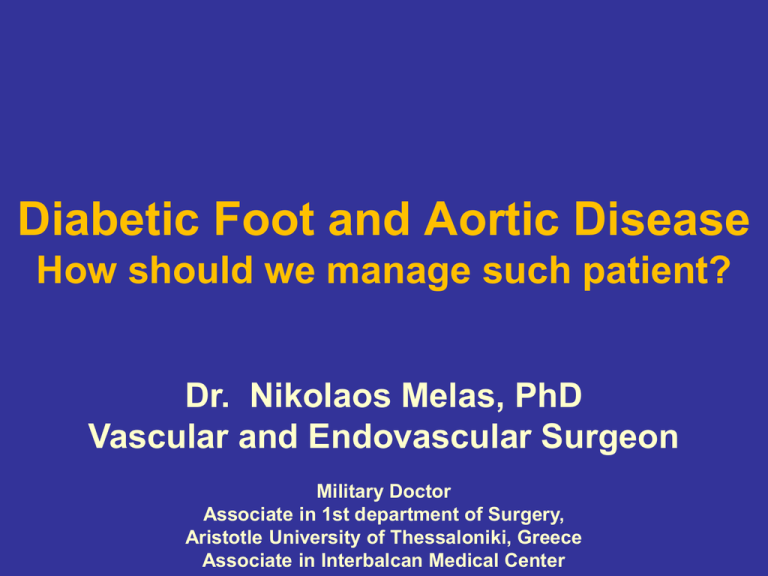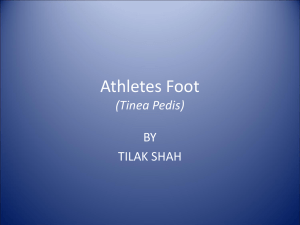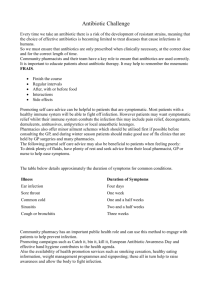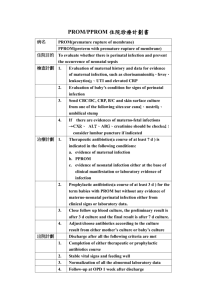
Diabetic Foot and Aortic Disease
How should we manage such patient?
Dr. Nikolaos Melas, PhD
Vascular and Endovascular Surgeon
Military Doctor
Associate in 1st department of Surgery,
Aristotle University of Thessaloniki, Greece
Associate in Interbalcan Medical Center
PAD
•
•
•
•
•
Aortoiliac
Femoropopliteal
Distal
Multifocal
Combined (with Coronary artery disease,
carotid artery disease, renal artery disease
and..)
Patterns of aortoiliac occlusive disease
10%
25%
Younger
Female
Smoking
High cholesterol
Manifested as I C
Better prognosis
65%
Older
Male
Many pred factors
High cholesterol
Manifested as CLI
Worse prognosis
Diabetics
along with profunda lesions
PAD and DM
• DM is not just a major predisposing factor for PAD
• PAD in diabetics comes earlier, is more pronounced
and is extended to distal arteries including profounda
femoris and distal below knee arteries.
• Has worse prognosis and prompt surgical therapy is
mandatory for limb salvage
• DM predisposes to foot infection even upon «normal»
distal arterial flow
Drugs for IC
•
•
•
•
•
•
•
•
•
Cilastazol 150mg x 2 daily
Naftidrofuryl 600 mg/day
Carnitine, L- Carnitine
Statins
Pentoxifylline
Asp
Prostaglandins (PGE1)
Buflomedil
Growth factor
LEHERT P, COMTE S, GAMAND S, BROWN TM. Naftidrofuryl in intermittent claudication: a retrospective analysis. J Cardiovasc Pharmacol 1994;23(Suppl. 3):S48eS52.
BOCCALON H, LEHERT P, MOSNIER M. Effect of naftidrofuryl on physiological walking distance in patients with intermittent claudication. Ann Cardiol Angeiol (Paris) 2001;50(3):175e182.
KIEFFER E, BAHNINI A, MOUREN X, GAMAND S. A new study demonstrates the efficacy of naftidrofuryl in the treatment of intermittent claudication. Findings of the Naftidrofuryl Clinical Ischemia Study (NCIS). Int Angiol 2001;20(1):58e65.
SPENGEL F, CLEMENT D, BOCCALON H, LIARD F, BROWN T, LEHERT P. Findings of the Naftidrofuryl in Quality of Life (NIQOL) European study program. Int Angiol 2002;21(1):20e27.
BREVETTI G, DIEHM C, LAMBERT D. European multicenter study on Propionyl-l-carnitine in intermittent claudication. J Am Coll Cardiol 1999;34:1618e1624.
HIATT W, REGENSTEINER J, CREAGER M, HIRSCH A, COOKE J, OLIN J et al. Propionyl-L-carnitine improves exercise performance and functional status in patients with claudication. Am J Med 2001;110(8):616e622.
MOHLER III E, HIATT W, CREAGER M. Cholesterol reduction with atorvastatin improves walking distance in patients with peripheral arterial disease. Circulation 2003;108(12):1481e1486.
MONDILLO S, BALLO P, BARBATI R, GUERRINI F, AMMATURO T, AGRICOLA E et al. Effects of simvastatin on walking performance and symptoms of intermittent claudication in hypercholesterolemic patients with peripheral vascular disease. Am J Med 2003; 114(5):359e364.
GIROLAMI B, BERNARDI E, PRINS M, TEN CATE J, HETTIARACHCHI R, PRANDONI P et al. Treatment of intermittent claudication with physical training, smoking cessation, pentoxifylline, or nafronyl: a meta-analysis. Arch Intern Med 1999;159(4):337e345.
HOOD SC, MOHER D, BARBER GG. Management of intermittent claudication with pentoxifylline: meta-analysis of randomized controlled trials. CMAJ 1996;155(8):1053e1059.
MOHER D, PHAM B, AUSEJO M, SAENZ A, HOOD S, BARBER G Pharmacological management of intermittent claudication: a metaanalysis of randomised trials. Drugs 2000;59(5):1057e1070.
BELCH J, BELL P, CREISSEN DEA, DORMANDY JA, KESTER RC, MCCOLLUM RD et al. Randomised, placebo-controlled, doubleblind study evaluating the efficacy and safety of AS-013, a prostaglandin E1 prodrug, in patients with intermittent claudication. Circulation 1997;95:2298e2302.
LIEVRE M, MORAND S, BESSE B, FIESSINGER J, BOISSEL J. Oral beraprost sodium, a prostaglandin I(2) analogue, for intermittent claudication: a double-blind, randomized, multicenter controlled trial. Beraprost et Claudication Intermittente (BERCI) Research Group. Circulation 2000;102(4):426e431.
MOHLER III E, HIATT W, OLIN J, WADE M, JEFFS R, HIRSCH A. Treatment of intermittent claudication with beraprost sodium, an orally active prostaglandin I2 analogue: a double-blinded, randomized, controlled trial. J Am Coll Cardiol 2003;41(10): 1679e1686.
DE BACKER T, VANDER STICHELE R, BOGAERT M. Buflomedil for intermittent claudication. Cochrane Database Syst Rev 2001: CD000988.
DE BACKER T, VANDER STICHELE R, WARIE H, BOGAERT M. Oral vasoactive medication in intermittent claudication: utile or futile? Eur J Clin Pharmacol 2000;56(3):199e206
REGENSTEINER J, WARE JJ, MCCARTHY W, ZHANG P, FORBES W, HECKMAN J et al. Effect of cilostazol on treadmill walking, community- based walking ability, and health-related quality of life in patients with intermittent claudication due to peripheral arterial disease: meta-analysis of six randomized controlled
trials. J Am Geriatr Soc 2002;50(12):1939e1946.
DAWSON D, CUTLER B, HIATT W, HOBSON R, MARTIN J, BORTEY E et al. A comparison of cilostazol and pentoxifylline for treating intermittent claudication. Am J Med 2000;109(7):523e530.
TBI instead of ABI
long-standing diabetes, renal failure and other disorders resulting in vascular
calcification can develop incompressible tibial arteries, which cause falsely high systolic
pressures.
Non-compressible measurements are defined as a very elevated ankle pressure (e.g.
250 mmHg) or ankle-brachial index (ABI) >1.40.
Measurement of toe pressures provides an accurate measurement of distal limb systolic
pressures in vessels that do not typically become non-compressible. A special small cuff
is used proximally on the first or second toe with a flow sensor, such as that used for
digital plethysmography.
The toe pressure is normally approximately 30 mmHg less than the ankle pressure and
an abnormal toe-brachial index (TBI) is <0.70.
False positive results with the TBI are unusual. The main limitation in patients with
diabetes is that it may be impossible to measure toe pressure in the first and second
toes due to inflammatory lesions, ulceration, or loss of tissue.
PATHOGENESIS OF DIABETIC FOOT ULCER AND AMPUTATION
Sensor
Joint
Neuropathy Mobility
Motor
Neuropathy
Autonomic
Neuropathy
PAD
Protective
sensation
Muscle atrophy and Sweating
2° foot deformities 2° dry skin
Ischemia
Foot pressure
Minor trauma
recognition
Foot pressure
Fissure
esp. over
bony prominences
Healing
Callus
Pre-ulcer
ULCER
Minor Trauma:
Mechanical
Chemical
Thermal
Infection
AMPUTATION
Interdigital laceration
(Moisture, Fungus)
MOTOR NEUROPATHY AND FOOT DEFORMITIES
• Hammer toes
• Claw toes
• Prominent metatarsal heads
• Hallux valgus
• Collapsed plantar arch
Hammer Toes
Claw Toes
From Boulton, et al Diabetic Medicine 1998, 15:508
Hallux Valgus
From Levin and Pfeifer, The Uncomplicated Guide to Diabetes Complications, 2002
erythema
©2006. American College of Physicians. All Rights Reserved.
Hallux valgus deformity and early hammertoe deformities from diabetic motor
neuropathy
©2006. American College of Physicians. All Rights Reserved.
hammer and claw-toe deformities
©2006. American College of Physicians. All Rights Reserved.
prominent metatarsal head
marked callus
high risk for ulceration
dry skin
©2006. American College of Physicians. All Rights Reserved.
pre-ulcer
©2006. American College of Physicians. All Rights Reserved.
pre-ulcer (callus with subcutaneous hemorrhage)
©2006. American College of Physicians. All Rights Reserved.
claw-toe deformity
Early ulceration
©2006. American College of Physicians. All Rights Reserved.
excessive moisture and concurrent fungal
infection
©2006. American College of Physicians. All Rights Reserved.
Multiple skeletal deformities
©2006. American College of Physicians. All Rights Reserved.
Charcot deformity
©2006. American College of Physicians. All Rights Reserved.
Diabetic foot infection
and aorto iliac disease
How should we manage such patient?
Diabetic patient
With foot infection
•History
•Physical examination
Evaluate
•circulation
•Healing potential
Evaluate extent of foot infection
imaging
•Medical treatment
•Iv antibiotics
Debride
Amputate
Drain infection
Abscess
Gangrene
Ulcer
Open joint
Cellulitis only
Start antibiotics
Resolves ?
Yes
Lab studies
Healing potential ?
No
Poor
good
Additional
imaging
Preventive
Foot care
Wound care and
wait for closure
Yes
Fails
Deep infection?
No
Revascularization
potential
Prolonged iv antibiotics
No
Heals
Persistent
infection ?
Yes
No
Infection Persists ?
Yes
Poor
Proximal closed
amputation
Good
Fails
Revascularize
and await for closure
with local care
Heals
Preventive
Foot care
Diabetic patient
With foot infection
•History
•Physical examination
Evaluate
•circulation
•Healing potential
Evaluate extent of foot infection
imaging
Cellulitis only
•Medical treatment
•Iv antibiotics
Debride
Amputate
Drain infection
Abscess
Gangrene
Ulcer
Open joint
Foot infections in Diabetics:
Start antibiotics
Resolves ?
Lab studies
Healing potential ?
•DueYesto sensory
neuropathy and defect in immune defense
No
Poor
good
•Osteoarthropathy
leads
to
joint
imbalance
and
irregular
pressure
Additional
imaging
Wound care and
points
wait for closure
Preventive
•Not
easily recognized Yes
unless prominent
Foot care
Fails
Heals
Deep infection?
•More serious including deep subfascial structuresNo
No
Revascularization
Persistent
•Few hoursProlonged
– 48hiv antibiotics
usually interpose between
initial
inoculation
and
potential
infection ?
Yes
generalization
No
Infection Persists ?
Yes
Poor
Proximal closed
amputation
Good
Fails
Revascularize
and await for closure
with local care
Heals
Preventive
Foot care
Diabetic patient
With foot infection
•History
•Physical examination
Evaluate
•circulation
•Healing potential
Evaluate extent of foot infection
imaging
History:
Cellulitis only
Lab studies
•Medical treatment
•Iv antibiotics
Abscess
Gangrene
Ulcer
Open joint
Co morbidities (COD,CAD,AH,COPD,CRI)
Start antibiotics
Resolves ?
Yes
Debride
Amputate
Drain infection
Healing potential ?
No
Poor
Physical examination:
Additional
good
imaging
Wound care and
wait for closure
Preventive
•Regular
feet physical examination
Yes
Foot care
Fails
Heals
Deep infection?
•Plantar space
is more prone to lacerations and deep infection
No
No
Revascularization
Persistent
•Check for cellulitis,
abscess
and
crepitus
from
gas
production
potential
infection ?
Prolonged iv antibiotics
•Evaluate arterial perfusion
Yes
No
Infection Persists ?
Yes
Poor
Proximal closed
amputation
Good
Fails
Revascularize
and await for closure
with local care
Heals
Preventive
Foot care
Diabetic patient
With foot infection
Evaluate extent of foot infection
imaging
Cellulitis only
•History
•Physical examination
Lab studies
Evaluate
•circulation
•Healing potential
•Medical treatment
•Iv antibiotics
Debride
Amputate
Drain infection
Abscess
Gangrene
Ulcer
Open joint
•WBC, CRP, ESR, blood glucose level, electrolytes, Urea
Start antibiotics
Nitrogen,
Resolvescreatinine
?
Yes
•ECG
Healing potential ?
No
Poor
Additional
imaging
good
Wound care and
wait for closure
Preventive
Yes
•Diabetic
foot + uncontrolled
blood glucose EMERGENCY
Foot care
Fails
Deep infection?
(septicemia and septic shock)
No
No
Revascularization
Persistent
Fluid resuscitation
potential
infection ?
Prolonged iv antibiotics
8-12 h before
surgical
Yes
Iv antibiotic
intervention
Hyperglycemia
control
No
Poor
Good
Infection Persists ? Yes
Cardiovascular instability correction
Revascularize
Proximal closed
amputation
Fails
and await for closure
with local care
Heals
Heals
Preventive
Foot care
Diabetic patient
With foot infection
•History
•Physical examination
Lab studies
Evaluate
•circulation
•Healing potential
Evaluate extent of foot infection
imaging
•Medical treatment
•Iv antibiotics
Abscess
Gangrene
Ulcer
Open joint
Cellulitis only
Early beginning of broad spectrum antibiotics
Start antibiotics
Resolves ?
Debride
Amputate
Drain infection
Healing potential ?
IdealYesquinolones
(G- and G+) + clindamycin or metronidazole
No
Poor
good
(anaerobic)Additional
imaging
Preventive
Foot care
Wound care and
wait for closure
Yes
Fails
Deep infection?
No
Revascularization
potential
Prolonged iv antibiotics
No
Heals
Persistent
infection ?
Yes
No
Infection Persists ?
Yes
Poor
Proximal closed
amputation
Good
Fails
Revascularize
and await for closure
with local care
Heals
Preventive
Foot care
Diabetic patient
With foot infection
•History
•Physical examination
Lab studies
Evaluate
•circulation
•Healing potential
Evaluate extent of foot infection
imaging
•Medical treatment
•Iv antibiotics
Debride
Amputate
Drain infection
Abscess
Gangrene
Ulcer
Open joint
Cellulitis only
Start antibiotics
Resolves ?
Healing potential ?
•ColorYesand temperature
could
be
misleading
(prominent
inflammation)
No
Poor
good
Additional
•Pulses palpation
(usually difficult due to edema). Might be present.
imaging
Wound care and
wait for closure
Preventive
Foot care
Yes usually false elevated
•ABI (arterioscl. Mockenbeck)
Fails
Deep infection?
No
•Toe pressure used
in the index is reliable
Prolonged iv antibiotics
Revascularization
potential
•If toe pressure is > 30 mmHg good healing potential
No
Infection Persists ?
Yes
Poor
No
Heals
Persistent
infection ?
Yes
Good
•Tco2 (transcutaneous oxygen tension) > 30 mmHg
good healing potential
Revascularize
Proximal closed
amputation
Fails
and await for closure
with local care
Heals
Preventive
Foot care
Diabetic patient
With foot infection
•History
•Physical examination
Lab studies
Evaluate
•circulation
•Healing potential
Evaluate extent of foot infection
By Imaging and examination
•Medical treatment
•Iv antibiotics
Debride
Amputate
Drain infection
Abscess
Gangrene
Ulcer
Open joint
Cellulitis only
Start antibiotics
Resolves ?
Healing potential ?
FootYes
X-raysNo(f, p, oblique) under magnification:
Poor
good
Additional
imaging
Gas in soft tissue
Preventive
Osteomyelitis
(unfortunately
insensitive)
Yes
Foot care
Wound care and
wait for closure
Fails
Deep infection?
No
Revascularization
potential
Prolonged iv antibiotics
MRI:
No
Heals
Persistent
infection ?
Yes
No
Infection Persists ?
Yes
Poor
Good
Sensitive from initial stage of osteomyelitis
Revascularize
Proximal closed
Fails
But not first line scan
and await for closure
amputation
with local care
Usually in persistent foot infection
Heals
Preventive
Foot care
Diabetic patient
With foot infection
•History
•Physical examination
Evaluate
•circulation
•Healing potential
Evaluate extent of foot infection
imaging
•Medical treatment
•Iv antibiotics
Debride
Amputate
Drain infection
Abscess
Gangrene
Ulcer
Open joint
Cellulitis only
Start antibiotics
Resolves ?
Yes
Lab studies
Healing potential ?
No
Poor
good
Additional
imaging
Preventive
Foot care
Wound care and
wait for closure
Yes
Fails
Deep infection?
No
Revascularization
potential
Prolonged iv antibiotics
No
Heals
Persistent
infection ?
Yes
No
Infection Persists ?
Yes
Poor
Proximal closed
amputation
Good
Fails
Revascularize
and await for closure
with local care
Heals
Preventive
Foot care
Diabetic patient
With foot infection
•History
•Physical examination
Evaluate
•circulation
•Healing potential
Evaluate extent of foot infection
imaging
Cellulitis only
Start antibiotics
Resolves ?
Yes
Lab studies
•Medical treatment
•Iv antibiotics
Debride
Amputate
Drain infection
Abscess
Gangrene
Ulcer
Open joint
Healing potential ?
No
Poor
good
Additional
imaging
Preventive
Foot care
Wound care and
wait for closure
Yes
Fails
Deep infection?
No
Heals
Revascularization
Persistent
•Insensate foot Noshould be regularly checked
for
laceration
or initial
potential
infection ?
Prolonged iv antibiotics
stage inflammation
Yes
•Podiatry,
calluses care
No
Poor
Good
Infection Persists ? Yes
•Foot hydration
Revascularize
Proximal
closed
Preventive
Fails
Heals
•Proper shoes (distribute weight
off
sensitive
such
as
and awaitlocations
for closure
amputation
Foot care
with local care
protruding metatarsal heads)
Diabetic patient
MRI:
•History
Lab studies
•Physical examination
With foot infection
•Closed spaces with abscess
•Deep
tissue infection
Evaluate
•Medical treatment
Evaluate extent of foot infection
•circulation
antibiotics
imaging
•Osteomyelitis (osteopenia, disturbance
in cortex and•Ivmedulla)
•Healing potential
•Beware of late onset osteomyelitis (2 weeks after inflammation)
Start antibiotics
Resolves ?
Yes
Debride
Amputate
Drain infection
Abscess
Gangrene
Ulcer
Open joint
Cellulitis only
Healing potential ?
No
Poor
good
Additional
imaging
Preventive
Foot care
Wound care and
wait for closure
Yes
Fails
Deep infection?
No
Prolonged iv antibiotics
Revascularization
potential
No
Persistent
infection ?
Scintigraphy:
Yes
•Technetium
(early osteomyel. Poor
detection withinGooddays)
No
Infection Persists ? Yes
•Gallium
Revascularize
Proximal
closed
Fails
Heals
•Indium labeled WBC
and await for closure
amputation
with local care
Heals
Preventive
Foot care
Diabetic patient
•Aggressive
antibiotic therapy
•History
•Physical examination
With foot infection
•Careful
local monitoring for worsening
Evaluate
•circulation
•Healing potential
Evaluate extent of foot infection
imaging
•Medical treatment
•Iv antibiotics
Debride
Amputate
Drain infection
Abscess
Gangrene
Ulcer
Open joint
Cellulitis only
Start antibiotics
Resolves ?
Yes
Lab studies
Healing potential ?
No
Poor
good
Additional
imaging
Preventive
Foot care
Wound care and
wait for closure
Yes
Fails
Deep infection?
No
Revascularization
potential
Prolonged iv antibiotics
No
Heals
Persistent
infection ?
Yes
No
Infection Persists ?
Yes
Poor
Proximal closed
amputation
Good
Fails
Revascularize
and await for closure
with local care
Heals
Preventive
Foot care
Diabetic patient
With foot infection
•History
•Physical examination
Evaluate
•circulation
•Healing potential
Evaluate extent of foot infection
imaging
Cellulitis only
Start antibiotics
Resolves ?
Yes
Lab studies
•Medical treatment
•Iv antibiotics
Drain infection
Debride
Amputate
+ antibiotics
Deep infection
Abscess
Gangrene
Ulcer
Open joint
Healing potential ?
No
Poor
Additional
imaging
Preventive
Foot care
Wound care and
wait for closure
Yes
Deep infection?
good
Fails
Heals
•Drain every closed
cavity and subfascial
space No Persistent
No
Revascularization
potential
infection ?
iv antibiotics
•Remove allProlonged
necrotizing
tissue
Yes
•Remove tendons
No
Poor
Good
Yes
Infection Persists ?/ osteom.
•Remove
devitalized
bones
•VAC sometimes helpful Proximal closed Fails Revascularize
Preventive
Heals
and await for closure
amputation
Foot care
with local
care local care
•Let the wound open to granulate
with every
day
Diabetic patient
With foot infection
•History
•Physical examination
Evaluate
•circulation
•Healing potential
Evaluate extent of foot infection
imaging
•Medical treatment
•Iv antibiotics
Debride
Amputate
Drain infection
Abscess
Gangrene
Ulcer
Open joint
Cellulitis only
Start antibiotics
Resolves ?
Yes
Lab studies
Healing potential ?
No
Poor
good
Additional
imaging
Preventive
Foot care
Wound care and
wait for closure
Yes
Fails
Deep infection?
No
Revascularization
potential
Prolonged iv antibiotics
No
Heals
Persistent
infection ?
Yes
No
Infection Persists ?
Yes
Poor
Proximal closed
amputation
Good
Fails
Revascularize
and await for closure
with local care
Heals
Preventive
Foot care
Diabetic patient
With foot infection
•History
•Physical examination
Evaluate
•circulation
•Healing potential
Evaluate extent of foot infection
imaging
•Medical treatment
•Iv antibiotics
Debride
Amputate
Drain infection
Abscess
Gangrene
Ulcer
Open joint
Cellulitis only
Start antibiotics
Resolves ?
Yes
Lab studies
Healing potential ?
No
Poor
good
Additional
imaging
Preventive
Foot care
Wound care and
wait for closure
Yes
Fails
Deep infection?
No
Revascularization
potential
Prolonged iv antibiotics
No
Heals
Persistent
infection ?
Yes
No
Infection Persists ?
Yes
Poor
Proximal closed
amputation
Good
Fails
Revascularize
and await for closure
with local care
Heals
Preventive
Foot care
Diabetic
patient
•U/S
(triplex)
With foot infection
•MRA
•CTA?
Evaluate extent of foot infection
imaging
•DSA
•History
•Physical examination
Evaluate
•circulation
•Healing potential
•Medical treatment
•Iv antibiotics
Debride
Amputate
Drain infection
Abscess
Gangrene
Ulcer
Open joint
Cellulitis only
Start antibiotics
Resolves ?
Yes
Lab studies
Healing potential ?
No
Poor
good
Additional
imaging
Preventive
Foot care
Wound care and
wait for closure
Yes
Fails
Deep infection?
No
Revascularization
potential
Prolonged iv antibiotics
No
Heals
Persistent
infection ?
Yes
No
Infection Persists ?
Yes
Poor
Proximal closed
amputation
Good
Fails
Revascularize
and await for closure
with local care
Heals
Preventive
Foot care
Diabetic patient
With foot infection
•History
•Physical examination
Evaluate
•circulation
•Healing potential
Evaluate extent of foot infection
imaging
•Medical treatment
•Iv antibiotics
Debride
Amputate
Drain infection
Abscess
Gangrene
Ulcer
Open joint
Cellulitis only
Start antibiotics
Resolves ?
Yes
Lab studies
Healing potential ?
No
Poor
good
Additional
imaging
Preventive
Foot care
Wound care and
wait for closure
Yes
Fails
Deep infection?
No
Revascularization
potential
Prolonged iv antibiotics
No
Heals
Persistent
infection ?
Yes
No
Infection Persists ?
Yes
Poor
Proximal closed
amputation
Good
Fails
Revascularize
and await for closure
with local care
Heals
Preventive
Foot care
Diabetic patient
With foot infection
•History
•Physical examination
Evaluate
•circulation
•Healing potential
Evaluate extent of foot infection
imaging
•Medical treatment
•Iv antibiotics
Debride
Amputate
Drain infection
Abscess
Gangrene
Ulcer
Open joint
Cellulitis only
Start antibiotics
Resolves ?
Yes
Lab studies
Healing potential ?
No
Poor
good
Additional
imaging
Preventive
Foot care
Wound care and
wait for closure
Yes
Fails
Deep infection?
No
Revascularization
potential
Prolonged iv antibiotics
No
Heals
Persistent
infection ?
Yes
No
Infection Persists ?
Yes
Poor
Proximal closed
amputation
Good
Fails
Revascularize
and await for closure
with local care
Heals
Preventive
Foot care
Diabetic patient
With foot infection
•History
•Physical examination
Evaluate
•circulation
•Healing potential
Evaluate extent of foot infection
imaging
•Medical treatment
•Iv antibiotics
Debride
Amputate
Drain infection
Abscess
Gangrene
Ulcer
Open joint
Cellulitis only
Start antibiotics
Resolves ?
Yes
Lab studies
Healing potential ?
No
Poor
good
Additional
imaging
Preventive
Foot care
Wound care and
wait for closure
Yes
Fails
Deep infection?
No
Revascularization
potential
Prolonged iv antibiotics
No
Heals
Persistent
infection ?
Yes
No
Infection Persists ?
Yes
Poor
Proximal closed
amputation
Good
Fails
Revascularize
and await for closure
with local care
Heals
Preventive
Foot care
Revascularization in patients
with diabetic foot and aortoiliac
disease
•Open reconstruction
•Endovascular procedures
Open surgical reconstruction for aorto-iliac
obstructive disease
•Aortoiliac endarterectomy
•Aortic graft insertion (aorto-bi-femoral Y
prosthesis)
•Extranatomic (rare)
•Vollmar iliac endarterectomy
Aortoiliac endarterectomy
Dos Santos 1947 for per arteries
Wylie 1952 for aortoiliac disease
Aortic graft insertion (aorto-bi-femoral Y prosthesis)
Prox anastomosis:
End to end fashion
End to side fashion
Distal anastomosis always End to side fashion
Aortic graft insertion (aorto-bi-femoral Y prosthesis)
Dacron silver or
PTFE
•Diabetics usually have multilevel occlusive disease
•Moderate inflow disease
•Including poor profunda
•Poor outflow vessels
•Rarely aortobifemoral reconstruction alone sufice
•In diabetic infection or gangrene (stage II B complicated, III and IV meaning CLI)
an adjunctive procedure is usually needed (profundoplasty, SFA stenting, by
pass?, distal PTA)
Vollmar endarterectomy
Endovascular procedures
•Percutaneous transluminal angioplasty
•Stenting (BE, SE, covered)
•Hybrid procedures (open and endo techniques)
PTA alone
1968 Charles Dotter
Stents
balloon expandable stents
•
•
•
•
•
•
Metal alloy (usually Stainless
steel)
Mounted over a Pta balloon
Reach a pre-designed
diameter (atm)
High radial force
Low conformability in
tortouosity
Good for aortic stenosis
self expanding stents
•
•
•
•
•
•
Metal alloy usually nitinol
Mounted inside a retrievable
catheter
Reach a pre-designed
diameter
Lw radial force
High conformability in
tortouosity
Poor indication for aortic
stenosis, good for iliacs
Covered stents
•Drug eluting stents
•Absorbable stents
Atherectomy
1.Directional atherectomy
2.Rotational atherectomy
3.Excisional atherectomy
4.Excimer laser atherectomy
TASC A lesion
Covered stent for iliac rupture
Conclusions
•DM could cause acute catastrophic foot infection even
in absence of perfusion defect.
•High index of suspicion of infection is mandatory for
limb salvage.
•In Diabetic patients with aortoiliac occlusive disease
before any reconstruction it is absolutely necessary to
achieve absence of infection in distal foot.
•Sometimes prompt surgical intervention with
debridement or even guillotine amputation is essential
and life saving









